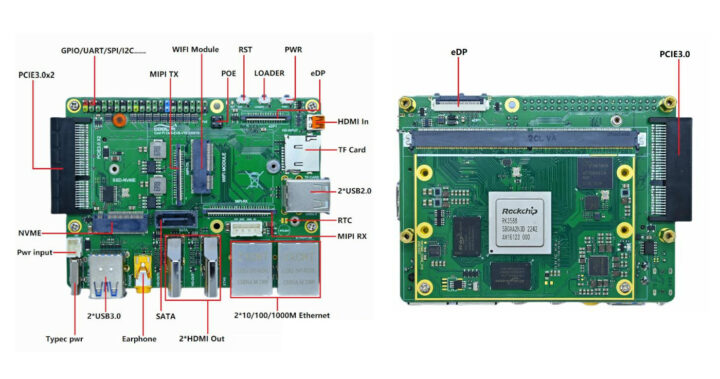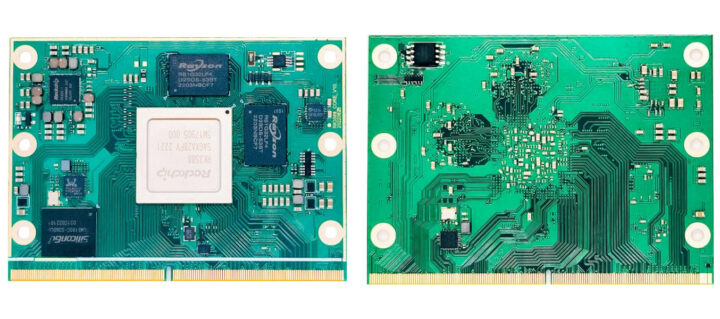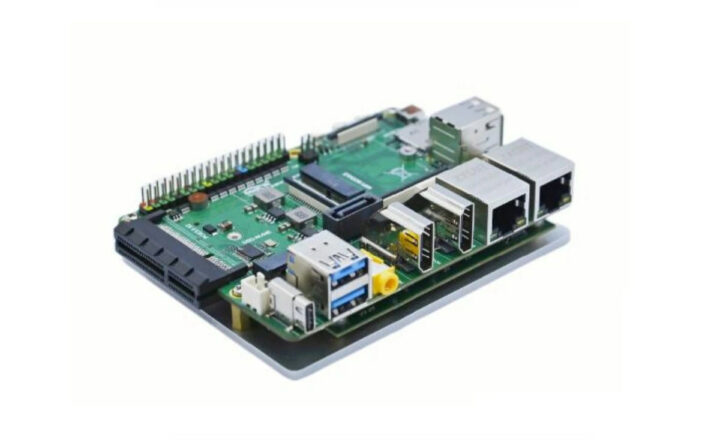Cool Pi CM5 is a system-on-module based on Rockchip RK3588 or RK3588J (industrial temperature range) octa-core Arm Cortex-A76/A55 processor with up to 32GB RAM, 256GB eMMC flash, offered with a development board with dual GbE, two 8K HDMI 2.1 ports, a PCIe 3.0 x2 slot, M.2 NVMe and SATA storage, and more…
At the end of last year, we wrote about the Cool Pi 4 as a much faster alternative to Raspberry Pi 4 SBC, and the company has now launched a Raspberry Pi Compute Module 4 and Radxa CM5 alternative with the Cool Pi CM5 MXM 3.0 system-on-module that they offer along with a feature-rich evaluation board (EVB).
Cool Pi CM5 EVB specifications:
- System-on-Module
- SoC – Rockchip RK3588(J) octa-core processor with
- System Memory – 2GB, 4GB, 8GB, 16GB, or 32GB LPDDR4/4X SDRAM
- Storage – 8GB, 16GB, 32GB, 64GB, 128GB, or 256GB eMMC flash memory
- Audio – Realtek ES8336 audio codec
- Networking – RTL8111HS and RTL8211F Gigabit Ethernet chips
- 314-pin MXM 3.0 edge connector for insertion into a carrier board
- Supply voltage – 4.2 to 4.8V DC
- Dimensions – 82 x 60 mm
- Temperature Range – Commercial: 0 to 70°C (RK3588); industrial: -40 to +85°C (RK3588J)
- Carrier board
- Storage – 1x SATA 3.0, M.2 2242 PCIe 3.0 x2 socket
- Video Output
- 2x HDMI 2.1 up to 8Kp60
- 2x eDP up to 4Kp60
- 4-lane MIPI DSI interface
- Video Input
- 2x 4-lane MIPI CSI or 4x 2-lane MIPI CSI connector
- Micro HDMI input up to 4Kp60
- Audio – 3.5mm earphone jack
- Networking
- 2x Gigabit Ethernet RJ45 ports, one with PoE support
- Optional WiFi/Bluetooth via M.2 module
- USB – 2x USB 3.0 Type-A ports, 4x USB 2.0 interfaces with 2x Type-A, 2x via headers
- Expansion
- PCIe 3.0 x2 slot
- M.2 2242 PCIe socket for SSD storage
- M.2 2230 PCIe socket for WiFi module
- 40-pin Raspberry Pi-compatible color-coded GPIO header
- Misc – Power, Reset, Loader buttons; RTC connector; thick heat spreader for cooling
- Power Supply
- 12V via USB Type-C or 2-pin connector
- PoE support via optional add-on
- Dimensions – 104 x 78 mm
 The Cool Pi CM5 EVB (RCP-CM5-EVB-2GNORK3588) is only offered with the commercial-grade CM5 module with 8GB RAM and 64GB flash, but the system-on-module itself is customizable and can be produced to be industrial grade with the Rockchip RK3588J processor.
The Cool Pi CM5 EVB (RCP-CM5-EVB-2GNORK3588) is only offered with the commercial-grade CM5 module with 8GB RAM and 64GB flash, but the system-on-module itself is customizable and can be produced to be industrial grade with the Rockchip RK3588J processor.
Just like the Cool Pi 4 Model B, the Cool Pi CM5 SoM and EVB can run Android 12, Ubuntu, and Debian operating systems with images and more technical details provided in the Wiki, and support offered in a bilingual (Chinese/English) forum. The board has a fanless design with cooling achieved via a heat spreader placed underneath the board in direct contact with the Rockchip RK3588 processor.

I don’t know pricing for the Cool Pi CM5 system-on-module, but samples of the Cool Pi CM5 EVB are sold on Aliexpress for $218.70 including shipping, but excluding potential taxes.

Jean-Luc started CNX Software in 2010 as a part-time endeavor, before quitting his job as a software engineering manager, and starting to write daily news, and reviews full time later in 2011.
Support CNX Software! Donate via cryptocurrencies, become a Patron on Patreon, or purchase goods on Amazon or Aliexpress






Not quite a Radxa CM5 or RPi CM4 alternative with that MXM edge connector, rather than the 100 pin Hirose B2B connectors…
Obviously, it has J version of the CPU. I wonder if rest of the components are certified for this temperature range.
“the system-on-module itself is customizable and can be produced to be industrial grade with the Rockchip RK3588J processor”
It only comes with the -J version if you customise your order.
There are many external PINs, and using BTB connectors requires more than 2, which makes production more difficult. Another issue is the height, and MXM can achieve a minimum of 1.5mm copper columns. In addition, incorrect disassembly of BTB connectors can easily cause damage.
I’m not commenting on the robustness or otherwise of connector choice, just that this product can’t be used as a drop in replacement for the RPi CM4 – or any other RPi CM format – because of the choice of connector.
It is very nice that more manufacturers are now adopting my idea of putting the soc on the bottom and venting heat directly to the case. Hardkernel was the first to listen to me, with Odroid N2.
> It is very nice that more manufacturers are now adopting my idea of putting the soc on the bottom and venting heat directly to the case. Hardkernel was the first to listen to me, with Odroid N2.
“Your idea” ? That’s a bit of a bold statement, especially given that several readers here have been begging vendors to do that since FriendlyELEC created the first NanoPI NEO that adopted this design in 2016, or 3 years before Odroid-N2 “listened to you”! I even exploited this original NanoPI design in my build farm built on top of the 4th generation of NanoPI NEO before Odroid-N2 was even announced. And Hardkernel already adopted it with their HC1 one year after the NanoPI, so actually they probably didn’t wait for your advice.
There’s no need to appropriate design rules like this, even if you possibly encouraged some vendors to do that and possibly participated a little bit to their adoption, like hundreds of other users who did the same. And it’s even quite possible that other vendors did it before FriendlyELEC though I’m not aware of any. By then we were told that there were challenges to solder BGA chips on the bottom and that not all board assemblers were able to do it, so it was mostly a technical difficulty, which nowadays seems to be completely solved.
> And Hardkernel already adopted it with their
U2 in 2012.
Ah yeah indeed, good catch, I had totally forgotten about that one!
Thanks for the informative rebuttals!